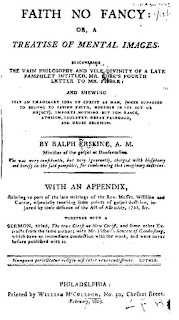WLC #109, Mental Images of Christ, and a Seceder View
By Benjamin P. Glaser - Posted at Mountains and Magnolias:
One of the most common exceptions taken in the ARP (and the PCA et al) by newly ordained men and those taking transfer exams in presbytery is without a doubt the clause in the explanation to Westminster Larger Catechism #109 concerning the prohibition against making mental images of the Godhead in accordance with the catechism’s teaching on the Second Commandment. I will post the question below:
Now there is a lot more there than just mental images and that is one of the criticisms this presbyter often has for those taking the exception, but that is a different argument for another post. As the title suggests my purpose is to provide a Seceder view against the taking of this exception and provide a positive defense for the Catechism. Probably the largest book ever written on this subject is a work called“Faith No Fancy, a Treatise On Mental Images” by one of the founders of the Seceder Church, a forerunner of my denomination, the ARP, Ralph Erskine. In this post I am going to provide relevant quotations by the author. Be advised that there will be regular updates as I read further and further into the work.
Read more here...
 |
| Faith No Fancy |
Q. 109. What sins are forbidden in the second commandment?
A. The sins forbidden in the second commandment are, all devising, counseling, commanding, using, and any wise approving, any religious worship not instituted by God himself; the making any representation of God, of all or of any of the three persons, either inwardly in our mind, or outwardly in any kind of image or likeness of any creature whatsoever; all worshiping of it, or God in it or by it; the making of any representation of feigned deities, and all worship of them, or service belonging to them; all superstitious devices, corrupting the worship of God, adding to it, or taking from it, whether invented and taken up of ourselves, or received by tradition from others, though under the title of antiquity, custom, devotion, good intent, or any other pretense whatsoever; simony; sacrilege; all neglect, contempt, hindering, and opposing the worship and ordinances which God hath appointed.
Now there is a lot more there than just mental images and that is one of the criticisms this presbyter often has for those taking the exception, but that is a different argument for another post. As the title suggests my purpose is to provide a Seceder view against the taking of this exception and provide a positive defense for the Catechism. Probably the largest book ever written on this subject is a work called“Faith No Fancy, a Treatise On Mental Images” by one of the founders of the Seceder Church, a forerunner of my denomination, the ARP, Ralph Erskine. In this post I am going to provide relevant quotations by the author. Be advised that there will be regular updates as I read further and further into the work.
Read more here...




Comments
Post a Comment
Welcome! Please feel free to comment, but anti-Christian comments or profanity will not be tolerated. Thank you, ed.